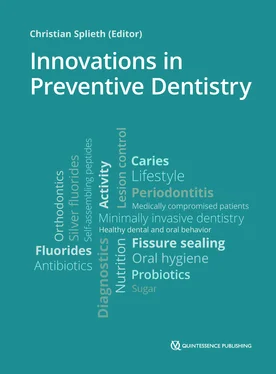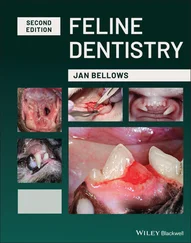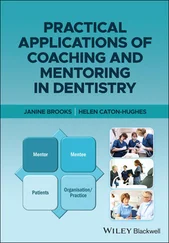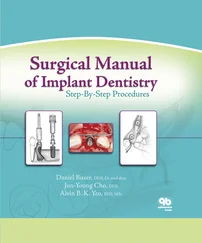A key issue of primary caries prevention is a change from caries activity to inactivation or, in other words, from predominantly demineralization to remineralization of dental hard tissues, which involves behavior change in the patients or caretaker (see Chapter 9). Especially after the caries decline, oral diseases are concentrated on a minority group, linked to the socioeconomic status. 27Thus, future gains in oral health must have a focus on this group, possibly employing all levels from individualized, group- and population-based prevention, outreach programs, and a common risk factor approach (see Chapter 5).
Secondary caries prevention aims to arrest or even remineralize initial caries lesions with nonoperative or minimally invasive techniques. These techniques involve nonrestorative caries control, which implements primary caries-preventive measures but employs them for initial or even cavitated caries lesions (see Chapter 14). This can be enhanced with silver fluoride products or other fluorides (see Chapters 3and 12), antimicrobials, or biomimetic remineralization using self-assembling peptides (Curodont Repair, Credentis), 28that work like a magnet for attracting minerals (see Chapter 13).
For management of initial caries lesions with intact macroscopic enamel surfaces, plaque control and fluoridation play a central role in arresting the lesions, promoting remineralization, and consequently avoiding further lesion progression to visible cavitation. It is known that tooth brushing with fluoridated toothpaste is the most cost-effective strategy for controlling caries lesions. 29,30
In addition, individualized preventive strategies that take into consideration patient’s caries risk/activity as well as involve parents and other care takers are key factors for successful intervention in caries control. One of the most effective caries prevention strategies is the “Next model.” 31,32These techniques are especially needed in patients with reduced cooperation, such as small children, persons with handicap, chronically ill patients, or elderly patients (see Chapter 16).
As minimally invasive techniques, therapeutic sealants can be used (see Chapter 10), even on proximal surfaces (Fig 1-7a). 33Another option is caries infiltration (Icon, DMG Dental; Fig 1-7b), where a resin-like material is diffused in the porous initial caries lesion. 34


Figs 1-7a and bMinimally invasive treatment of approximal initial caries lesions by (a) therapeutic sealants and (b) caries infiltration with Icon (DMG Dental).
“Tertiary” caries prevention tries to prevent progression of the disease and subsequent complication. Traditionally, complete removal of carious tissue with subsequent restorative treatment was regarded as the standard treatment for carious teeth. In recent years, there has been a paradigm shift in caries understanding: Caries is no longer understood as an infectious disease, but as the result of an ecologic imbalance, which is triggered, for instance, by the frequent consumption of fermentable carbohydrates (see above). In the biofilm, among other things, carbohydrates are metabolized to acids, which cause demineralization of the tooth structure. Not only in the field of primary caries prevention is this of fundamental importance, but also for the treatment of cavitated caries lesions, dentin demineralization, and (amount of) removal of carious tissues. For instance certain techniques encourage inactivation of caries lesions without carious tissue removal, such as nonrestorative cavity control, 35,36presented in Chapter 14. Here, also the silver agents 37(see Chapter 12) or sealing techniques with no carious tissue removal using preformed metal crowns like the Hall Technique 35are part of the modern caries management spectrum.
Thus, it is possible to control or arrest caries by disturbing the biofilm and influencing the de- and remineralization processes at any time and stage during lesion development. 38,39For cavitated caries lesions, biologically based techniques such as the selective (to firm, to leathery, to soft dentin) or stepwise carious tissue removal are currently advocated. These techniques are recommended for the management of shallow, moderately deep, and deep lesions in vital teeth in order to prevent pulpal exposure and to preserve the pulp vitality of the carious tooth. 40
References
1.Machiulskiene V, Campus G, Carvalho JC, et al. Terminology of dental caries and dental caries management: Consensus Report of a Workshop Organized by ORCA and Cariology Research Group of IADR. Caries Res 2020;54:7–14.
2.IDZ. Fünfte Deutsche Mundgesundheitsstudie – DMS V. Köln, 2016.
3.Team DAJ. Epidemiologische Begleituntersuchungen zur Gruppenprophylaxe 2016. 1st ed. Bonn: Deutsche Arb.-Gemeinsch. f. Jugendzahnpflege, 2017.
4.Splieth CH, Santamaria RM, Basner R, Schüler E, Schmoeckel J. 40-year longitudinal caries development in german adolescents in the light of new caries measures. Caries Res 2019;53:609–616.
5.Schmidt CO, Fahland RA, Franze M, et al. Health-related behaviour, knowledge, attitudes, communication and social status in school children in Eastern Germany. Health Educ Res 2010;25:542–551.
6.Chen KJ, Gao SS, Duangthip D, Lo ECM, Chu CH. Prevalence of early childhood caries among 5-year-old children: a systematic review. J Investig Clin Dent 2019;10:e12376.
7.Santamaria RM, Schmoeckel J, Basner R, Schüler E, Splieth CH. Caries trends in the primary dentition of 6- to 7-year-old schoolchildren in Germany from 1994 to 2016: Results from the German National Oral Health Surveys in Children. Caries Res 2019;53:659–666.
8.Kassebaum NJ, Bernabé E, Dahiya M, Bhandari B, Murray CJL, Marcenes W. Global burden of untreated caries: a systematic review and metaregression. J Dent Res 2015; 94:650–658.
9.Vollú AL, da Costa MdEPR, Maia LC, Fonseca-Gonçalves A. Evaluation of oral health-related quality of life to assess dental treatment in preschool children with early childhood caries: a preliminary study. J Clic Pediatr Dent 2018;42:37–44.
10.DPHEP. National Dental Epidemiology Programme for England: oral health survey of five-year-old children 2015. London: Public Health England, 2016.
11.Turton B, Chher T, Sabbah W, Durward C, Hak S, Lailou A. Epidemiological survey of early childhood caries in Cambodia. BMC Oral Health 2019;19:107.
12.Slabsinskiene E, Milciuviene S, Narbutaite J, et al. Severe early childhood caries and behavioral risk factors among 3-year-old children in Lithuania. Medicina (Kaunas, Lithuania) 2010;46:135–141.
13.Prakash P, Subramaniam P, Durgesh BH, Konde S. Prevalence of early childhood caries and associated risk factors in preschool children of urban Bangalore, India: a cross-sectional study. Eur J Dent 2012;6:141–152.
14.Livny A, Assali R, Sgan-Cohen HD. Early childhood caries among a Bedouin community residing in the eastern outskirts of Jerusalem. BMC Public Health 2007;7:167.
15.Postma TC, Ayo-Yusuf OA, van Wyk PJ. Socio-demographic correlates of early childhood caries prevalence and severity in a developing country: South Africa. Int Dent J 2008;58:91–97.
16.Colak H, Dülgergil CT, Dalli M, Hamidi MM. Early childhood caries update: a review of causes, diagnoses, and treatments. J Nat Sci Biol Med 2013;4:29–38.
17.Schmoeckel J, Santamaría RM, Basner R, Schüler E, Splieth CH. Introducing a specific term to present caries experience in populations with low caries prevalence: Specific affected Caries index (SaC). Caries Res 2019;53: 527–531.
Читать дальше














